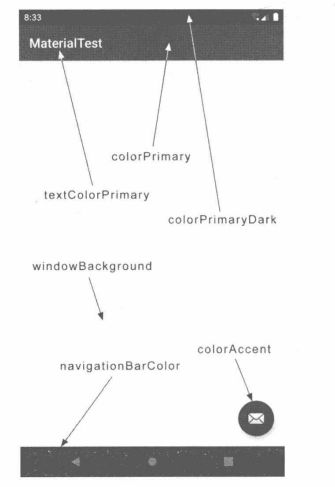12-Material Design实战(UI)
最佳的UI体验,Material Design实战
什么是Material Design
精美的UI设计语言
学习Material Design中的控件
1. Toolbar
还记得我们每次打开的程序的标题栏吗?啊对,那不是toolbar做的.但是,那是actionbar做的,Toolbar可以说是Actionbar的升级版了。Toolbar不仅有Actionbar的所有功能,而且还更加灵活.
Actionbar是默认显示的
其实这是在项目中指定的主题来显示的
<manifest xmlns:android="http://schemas.android.com/apk/res/android"
package="com.bo.a1_material">
<application
···
android:theme="@style/AppTheme">
···
application>
manifest>
那么这个Theme.1_Material主题到底在哪里呢?在res/values/themes.xml文件中
<resources>
<style name="AppTheme" parent="Theme.AppCompat.DayNight.DarkActionBar">
- "colorPrimary"
>@color/purple_500
- "colorPrimaryDark">@color/black
- "colorAccent">@color/black
- "android:textColorPrimary">@color/black
- "android:navigationBarColor">@color/purple_200
- "android:windowBackground">@color/white
style>
resources>

指定了一个叫做AppTheme的主题,他的父主题是Theme.Theme.AppCompat.DayNight.DarkActionBar是一个深色主题的意思
现在我们需要指定不带Actionbar的主题
通常有两种主题Theme.AppCompat.NoActionBar深色主题Theme.AppCompat.Light.NoActionBar浅色主题
现在已经把ActionBar隐藏起来了,可以用ToolBar了
<FrameLayout xmlns:android="http://schemas.android.com/apk/res/android"
xmlns:app="http://schemas.android.com/apk/res-auto"
xmlns:tools="http://schemas.android.com/tools"
android:layout_width="match_parent"
android:layout_height="match_parent"
tools:context=".MainActivity">
<androidx.appcompat.widget.Toolbar
android:layout_width="match_parent"
android:layout_height="?attr/actionBarSize"
android:id="@+id/toolbar"
android:background="@color/purple_500"
android:theme="@style/ThemeOverlay.AppCompat.Dark.ActionBar"
app:popupTheme="@style/ThemeOverlay.AppCompat.Light"/>
FrameLayout>
ToolBar常见功能
<manifest xmlns:android="http://schemas.android.com/apk/res/android"
···>
<application
···>
<activity
···
android:label="Fruits">
···
activity>
application>
manifest>
把按钮放在toolbar中,空间不足就放在菜单里面
<menu xmlns:android="http://schemas.android.com/apk/res/android"
xmlns:app="http://schemas.android.com/apk/res-auto">
<item
android:id="@+id/backup"
android:icon="@drawable/ic_backup"
android:title="Backup"
app:showAsAction="always"/>
<item
android:id="@+id/delete"
android:icon="@drawable/ic_delete"
android:title="Delete"
app:showAsAction="ifRoom"/>
<item
android:id="@+id/setting"
android:icon="@drawable/ic_settings"
android:title="Setting"
app:showAsAction="never"/>
menu>
class MainActivity : AppCompatActivity() {
private lateinit var binding: ActivityMainBinding
override fun onCreate(savedInstanceState: Bundle?) {
super.onCreate(savedInstanceState)
binding= ActivityMainBinding.inflate(layoutInflater)
setContentView(binding.root)
setSupportActionBar(binding.toolbar)
}
override fun onCreateOptionsMenu(menu: Menu?): Boolean {
menuInflater.inflate(R.menu.toolbar,menu)
return true
}
override fun onOptionsItemSelected(item: MenuItem): Boolean {
when(item.itemId){
R.id.backup->Toast.makeText(this,"点击了backup",Toast.LENGTH_SHORT).show()
R.id.delete->Toast.makeText(this,"点击了delete",Toast.LENGTH_SHORT).show()
R.id.setting->Toast.makeText(this,"点击了setting",Toast.LENGTH_SHORT).show()
}
return true
}
}
滑动菜单
DrawerLayout
布局----在这个布局中允许放入两个直接子控件,
- 屏幕中显示的内容
- 滑动菜单中显示的内容
<androidx.drawerlayout.widget.DrawerLayout
xmlns:app="http://schemas.android.com/apk/res-auto"
xmlns:tools="http://schemas.android.com/tools"
xmlns:android="http://schemas.android.com/apk/res/android"
android:layout_width="match_parent"
android:layout_height="match_parent"
tools:context=".MainActivity"
android:id="@+id/drawLayout">
<FrameLayout
android:layout_width="match_parent"
android:layout_height="match_parent">
<androidx.appcompat.widget.Toolbar
android:layout_width="match_parent"
android:layout_height="?attr/actionBarSize"
android:id="@+id/toolbar"
android:background="@color/purple_500"
android:theme="@style/ThemeOverlay.AppCompat.Dark.ActionBar"
app:popupTheme="@style/ThemeOverlay.AppCompat.Light"/>
FrameLayout>
<TextView
android:layout_width="match_parent"
android:layout_height="match_parent"
android:background="#FFF"
android:layout_gravity="left"
android:text="菜单"
android:textSize="30sp"/>
androidx.drawerlayout.widget.DrawerLayout>
加入一个导航图标指示用户使用滑动菜单
class MainActivity : AppCompatActivity() {
private lateinit var binding: ActivityMainBinding
override fun onCreate(savedInstanceState: Bundle?) {
···
supportActionBar?.let {//获得ActionBar的实例
it.setDisplayHomeAsUpEnabled(true)//当ActionBar不为空的时候就让导航按钮显示出来
it.setHomeAsUpIndicator(R.drawable.ic_menu)//设置一个导航按钮图标(默认是叫做home按钮,默认的图标是返回箭头,含义是返回上一个Activity)
}
}
···
override fun onOptionsItemSelected(item: MenuItem): Boolean {
when(item.itemId){
/*home按钮的id永远是android.R.id.home*/
android.R.id.home->binding.drawLayout.openDrawer(GravityCompat.START)
···
}
return true
}
}
NavigationView
滑动窗口里面用TextView太丑了,尝试尝试NavigationView
需要把库引入项目才行
dependencies {
···
implementation 'com.google.android.material:material:1.0.0'
Material库
implementation 'de.hdoenhof:circleimageview:3.0.1'
开源项目CircleImageView,可以轻松实现图片圆形化
}
<menu xmlns:android="http://schemas.android.com/apk/res/android">
<group android:checkableBehavior="single">
<item
android:id="@+id/navCall"
android:icon="@drawable/nav_call"
android:title="打电话"/>
<item
android:id="@+id/navFriend"
android:icon="@drawable/nav_friends"
android:title="朋友"/>
<item
android:id="@+id/navLocation"
android:icon="@drawable/nav_location"
android:title="位置"/>
<item
android:id="@+id/navTask"
android:icon="@drawable/nav_task"
android:title="记事本"/>
group>
menu>
<RelativeLayout xmlns:android="http://schemas.android.com/apk/res/android"
android:layout_width="match_parent"
android:layout_height="180dp"
android:padding="10dp"
android:background="@color/purple_200">
<de.hdodenhof.circleimageview.CircleImageView
android:layout_width="70dp"
android:layout_height="70dp"
android:id="@+id/iconImage"
android:src="@drawable/nav_icon"
android:layout_centerInParent="true"/>
<TextView
android:layout_width="wrap_content"
android:layout_height="wrap_content"
android:id="@+id/mailText"
android:layout_alignParentBottom="true"
android:text="[email protected]"
android:textColor="#FFF"
android:textSize="14sp"/>
<TextView
android:layout_width="wrap_content"
android:layout_height="wrap_content"
android:id="@+id/userText"
android:layout_above="@+id/mailText"
android:text="123456"
android:textColor="#FFF"
android:textSize="14sp"/>
RelativeLayout>
<androidx.drawerlayout.widget.DrawerLayout
xmlns:app="http://schemas.android.com/apk/res-auto"
xmlns:tools="http://schemas.android.com/tools"
xmlns:android="http://schemas.android.com/apk/res/android"
android:layout_width="match_parent"
android:layout_height="match_parent"
tools:context=".MainActivity"
android:id="@+id/drawLayout">
<FrameLayout
android:layout_width="match_parent"
android:layout_height="match_parent">
<androidx.appcompat.widget.Toolbar
android:layout_width="match_parent"
android:layout_height="?attr/actionBarSize"
android:id="@+id/toolbar"
android:background="@color/purple_500"
android:theme="@style/ThemeOverlay.AppCompat.Dark.ActionBar"
app:popupTheme="@style/ThemeOverlay.AppCompat.Light"/>
FrameLayout>
<com.google.android.material.navigation.NavigationView
android:layout_width="match_parent"
android:layout_height="match_parent"
android:id="@+id/navView"
android:layout_gravity="start"
app:headerLayout="@layout/nav_header"
app:menu="@menu/nav_menu"
/>
androidx.drawerlayout.widget.DrawerLayout>
悬浮按钮和可交互提示
FloatingActionButton
是Material中的控件,可以轻松实现悬浮按钮
悬浮按钮会默认使用colorAccent作为按钮的颜色,还可以用一个图标来表明这个按钮的作用
<androidx.drawerlayout.widget.DrawerLayout
···>
<FrameLayout
android:layout_width="match_parent"
android:layout_height="match_parent">
···
<com.google.android.material.floatingactionbutton.FloatingActionButton
android:layout_width="wrap_content"
android:layout_height="wrap_content"
android:id="@+id/fab"
android:layout_gravity="bottom|end"
android:layout_margin="16dp"
android:src="@drawable/ic_done"
app:elevation="8dp"/>
FrameLayout>
···
androidx.drawerlayout.widget.DrawerLayout>
Snackbar
Toast提示是不是有点拉,可以用Snackbar提示
但是Toast并非是不如Snackbar,他们有不同的应用场景
- Toast只能告诉用户现在发生了什么事情,用户只能被动接收这件事情
- Snackbar允许在提示中加入一个可交互按钮,当用户点击按钮的时候,就可以执行一些额外的逻辑操作
class MainActivity : AppCompatActivity() {
private lateinit var binding: ActivityMainBinding
override fun onCreate(savedInstanceState: Bundle?) {
···
binding.fab.setOnClickListener { view ->
Snackbar.make(view, "删除数据", Snackbar.LENGTH_SHORT)
.setAction("Undo") {
Toast.makeText(this, "数据恢复", Toast.LENGTH_SHORT).show()
}.show()
}
}
···
但是此时我们会发现Snackbar弹出的时候会把悬浮按钮遮住,但是这个问题我们可以用CoordinatorLayout解决
CoordinatorLayout
- CoordinatorLayout可以是一种加强版的FrameLayout(帧布局)
- CoordinatorLayout会监听所有子控件的各种事件,并且自动帮助我们做出最为合理的响应
<androidx.drawerlayout.widget.DrawerLayout
xmlns:app="http://schemas.android.com/apk/res-auto"
xmlns:tools="http://schemas.android.com/tools"
xmlns:android="http://schemas.android.com/apk/res/android"
android:layout_width="match_parent"
android:layout_height="match_parent"
tools:context=".MainActivity"
android:id="@+id/drawLayout">
<androidx.coordinatorlayout.widget.CoordinatorLayout
···>
···
androidx.coordinatorlayout.widget.CoordinatorLayout>
···
androidx.drawerlayout.widget.DrawerLayout>
其实就是把原本的FrameLayout布局改成了androidx.coordinatorlayout.widget.CoordinatorLayout就行了
效果就是当点击悬浮按钮Snackbar出现的时候,悬浮按钮会上移来适应Snackbar是自己不会被Snackbar遮住
但是Snackbar并不是CoordinatorLayout的子控件,而是DrawerLayout的子控件,为什么也能成功呢?
是因为Snackbar.make()传入了一个view,这是用来指定Snackbar是哪个View触发的,所以传入的是悬浮按钮控件本身,悬浮按钮控件是CoordinatorLayout的子控件,所以能成功
卡片式布局
虽然之前的操作已经有了很多的内容,但是屏幕中心追重要的部分还没有内容
MaterialCardView
MaterialCardView其实也是一个升级版的FrameLayout,他只是额外提供了圆角和阴影等效果,看起来会更加立体
直接来,在代码里看作用吧
dependencies {
···
implementation 'androidx.recyclerview:recyclerview:1.0.0'
/*添加recyclerview的依赖*/
implementation 'com.github.bumptech.glide:glide:4.9.0'
/* 添加gilde的依赖,gilde可以加载图片,甚至是gif图和本地视频*/
}
<androidx.drawerlayout.widget.DrawerLayout
···>
<androidx.coordinatorlayout.widget.CoordinatorLayout
android:layout_width="match_parent"
android:layout_height="match_parent">
···
<androidx.recyclerview.widget.RecyclerView
android:layout_width="match_parent"
android:layout_height="match_parent"
android:id="@+id/recyclerView"/>
···
androidx.coordinatorlayout.widget.CoordinatorLayout>
···
androidx.drawerlayout.widget.DrawerLayout>
<com.google.android.material.card.MaterialCardView
xmlns:android="http://schemas.android.com/apk/res/android"
xmlns:app="http://schemas.android.com/apk/res-auto"
android:layout_width="match_parent"
android:layout_height="wrap_content"
android:layout_margin="5dp"
app:cardCornerRadius="4dp">
<LinearLayout
android:layout_width="match_parent"
android:layout_height="wrap_content"
android:orientation="vertical">
<ImageView
android:id="@+id/fruitImage"
android:layout_width="match_parent"
android:layout_height="100dp"
android:scaleType="centerCrop"
android:contentDescription="TODO" />
<TextView
android:id="@+id/fruitName"
android:layout_width="wrap_content"
android:layout_height="wrap_content"
android:layout_gravity="center_horizontal"
android:layout_margin="5dp"
android:textSize="16sp" />
LinearLayout>
com.google.android.material.card.MaterialCardView>
class FruitAdapter(private val context: Context, private val fruitList:List<Fruit>):
RecyclerView.Adapter<FruitAdapter.ViewHolder>(){
inner class ViewHolder(view:View):RecyclerView.ViewHolder(view){
val fruitName:TextView=view.findViewById(R.id.fruitName)
val fruitImage:ImageView=view.findViewById(R.id.fruitImage)
}
override fun onCreateViewHolder(parent: ViewGroup, viewType: Int): ViewHolder {
val view=LayoutInflater.from(context).inflate(R.layout.fruit_item,parent,false)
return ViewHolder(view)
}
override fun onBindViewHolder(holder: ViewHolder, position: Int) {
val fruit=fruitList[position]
holder.fruitName.text=fruit.name
Glide.with(context).load(fruit.imageId).into(holder.fruitImage)
}
override fun getItemCount(): Int {
return fruitList.size
}
}
class MainActivity : AppCompatActivity() {
private lateinit var binding: ActivityMainBinding
private val fruits=mutableListOf(
Fruit("Apple", R.drawable.apple),
Fruit("Banana", R.drawable.banana),
Fruit("Orange", R.drawable.orange),
Fruit("Watermelon", R.drawable.watermelon),
Fruit("Pear", R.drawable.pear),
Fruit("Grape", R.drawable.grape),
Fruit("Pineapple", R.drawable.pineapple),
Fruit("Strawberry", R.drawable.strawberry),
Fruit("Cherry", R.drawable.cherry),
Fruit("Mango", R.drawable.mango))
private val fruitList=ArrayList<Fruit>()
override fun onCreate(savedInstanceState: Bundle?) {
···
initFruits()
/*GridLayoutManager标准网格布局的布局管理器,此处是指在这个布局中,一行两个,对齐高度一致*/
val layoutManager= GridLayoutManager(this,2)
binding.recyclerView.layoutManager=layoutManager
val adapter=FruitAdapter(this,fruitList)
binding.recyclerView.adapter=adapter
}
private fun initFruits(){
fruitList.clear()
repeat(50){
val index=(0 until fruits.size).random()
fruitList.add(fruits[index])
}
}
···
}
我们会发现Toolbar会被Recyclerview挡住,这就要借助AppBarlayout来解决了
AppBarLayout
CoordinatorLayout是加强版的FrameLayout,在不进行明确定位的情况下所有控件会默认放在布局的左上角,从而产生了遮挡的情况
AppBarLayout实际上是个垂直方向上的Linearlayout,他的内部做了很多滚动事件的封装,并且应用了一些Matrial Design的设计理念
我们只需要把Toolbar放在AppBarLayout中就可以了
<androidx.drawerlayout.widget.DrawerLayout
···>
<androidx.coordinatorlayout.widget.CoordinatorLayout
android:layout_width="match_parent"
android:layout_height="match_parent">
<com.google.android.material.appbar.AppBarLayout
android:layout_width="match_parent"
android:layout_height="wrap_content">
<androidx.appcompat.widget.Toolbar
···
app:layout_scrollFlags="scroll|enterAlways|snap"/>
com.google.android.material.appbar.AppBarLayout>
<androidx.recyclerview.widget.RecyclerView
···
app:layout_behavior="@string/appbar_scrolling_view_behavior"/>
···
androidx.coordinatorlayout.widget.CoordinatorLayout>
···
androidx.drawerlayout.widget.DrawerLayout>
下来刷新
SwipeRefreshLaout就是用于下拉刷新功能的核心类在Androidx库中
把想要实现下拉刷新的控件放到SwipeRefreshLaout中,就可迅速让这个控件刷新
dependencies {
···
implementation "androidx.swiperefreshlayout:swiperefreshlayout:1.0.0"
}
<androidx.drawerlayout.widget.DrawerLayout
xmlns:app="http://schemas.android.com/apk/res-auto"
xmlns:tools="http://schemas.android.com/tools"
xmlns:android="http://schemas.android.com/apk/res/android"
android:layout_width="match_parent"
android:layout_height="match_parent"
tools:context=".MainActivity"
android:id="@+id/drawLayout">
<androidx.coordinatorlayout.widget.CoordinatorLayout
android:layout_width="match_parent"
android:layout_height="match_parent">
···
<androidx.swiperefreshlayout.widget.SwipeRefreshLayout
android:id="@+id/swipeRefresh"
android:layout_width="match_parent"
android:layout_height="match_parent"
app:layout_behavior="@string/appbar_scrolling_view_behavior">
<androidx.recyclerview.widget.RecyclerView
android:layout_width="match_parent"
android:layout_height="match_parent"
android:id="@+id/recyclerView"/>
androidx.swiperefreshlayout.widget.SwipeRefreshLayout>
···
androidx.coordinatorlayout.widget.CoordinatorLayout>
androidx.drawerlayout.widget.DrawerLayout>
class MainActivity : AppCompatActivity() {
···
override fun onCreate(savedInstanceState: Bundle?) {
···
binding.swipeRefresh.setColorSchemeResources(R.color.purple_700)
//设置刷新时进度条的颜色
binding.swipeRefresh.setOnRefreshListener {
//下拉刷新的监听器
refreshFruits(adapter)
}
}
private fun refreshFruits(adapter: FruitAdapter){
//在子线程中开启对UI的操作
thread {
Thread.sleep(1000)//让子线程沉睡1秒,不然看不到刷新的效果
runOnUiThread { //要借助异步消息处理机制,让UI操作在主线程中进行
initFruits()
adapter.notifyDataSetChanged()//通过适配器来刷新数据变化
binding.swipeRefresh.isRefreshing=false//表示刷新事件结束了,并且会隐藏刷新进度条,默认是true不结束不隐藏
}
}
}
···
}
可折叠式标题栏
我们当前的标题的使用Toolbar,但是其实和Actionbar差别不大,只不过可以响应recyclerview的滚动事件而已,我们可以使用collapsingToolbarLayout让标题栏更华丽
- collapsingToolbarLayout是不能单独存在的,他必须是AppBarLayout的子布局
- AppBarLayout也是不能单独存在的,它必须是CoordinatorLayout的子布局
<androidx.coordinatorlayout.widget.CoordinatorLayout
xmlns:android="http://schemas.android.com/apk/res/android"
xmlns:app="http://schemas.android.com/apk/res-auto"
xmlns:tools="http://schemas.android.com/tools"
android:layout_width="match_parent"
android:layout_height="match_parent">
<com.google.android.material.appbar.AppBarLayout
android:layout_width="match_parent"
android:layout_height="250dp"
android:id="@+id/appBar">
<com.google.android.material.appbar.CollapsingToolbarLayout
android:layout_width="match_parent"
android:layout_height="match_parent"
android:id="@+id/collapsingToolbar"
android:background="@color/purple_200"
android:theme="@style/ThemeOverlay.AppCompat.Dark.ActionBar"
app:contentScrim="@color/black"
app:layout_scrollFlags="scroll|exitUntilCollapsed">
<ImageView
android:layout_width="match_parent"
android:layout_height="match_parent"
android:id="@+id/fruitImageView"
android:scaleType="centerCrop"
app:layout_collapseMode="parallax"/>
<androidx.appcompat.widget.Toolbar
android:layout_width="match_parent"
android:layout_height="?android:attr/actionBarSize"
android:id="@+id/toolbar"
app:layout_collapseMode="pin"/>
com.google.android.material.appbar.CollapsingToolbarLayout>
com.google.android.material.appbar.AppBarLayout>
<androidx.core.widget.NestedScrollView
android:layout_width="match_parent"
android:layout_height="match_parent"
app:layout_behavior="@string/appbar_scrolling_view_behavior">
<LinearLayout
android:layout_width="match_parent"
android:layout_height="wrap_content"
android:orientation="vertical">
<com.google.android.material.card.MaterialCardView
android:layout_width="match_parent"
android:layout_height="wrap_content"
android:layout_marginTop="35dp"
android:layout_marginLeft="15dp"
android:layout_marginBottom="15dp"
android:layout_marginRight="15dp"
app:cardCornerRadius="4dp">
<TextView
android:layout_width="wrap_content"
android:layout_height="wrap_content"
android:id="@+id/fruitContentText"
android:layout_margin="10dp"/>
com.google.android.material.card.MaterialCardView>
LinearLayout>
androidx.core.widget.NestedScrollView>
<com.google.android.material.floatingactionbutton.FloatingActionButton
android:layout_width="wrap_content"
android:layout_height="wrap_content"
android:layout_margin="16dp"
android:src="@drawable/ic_comment"
app:layout_anchor="@id/appBar"
app:layout_anchorGravity="bottom|end"
tools:ignore="SpeakableTextPresentCheck"
android:id="@+id/floatingBtn"/>
androidx.coordinatorlayout.widget.CoordinatorLayout>
class FruitActivity:AppCompatActivity() {
companion object{
const val FRUIT_NAME="fruit_name"
const val FRUIT_IMAGE_ID="fruit_image_id"
}
private lateinit var binding: ActivityFruitBinding
override fun onCreate(savedInstanceState: Bundle?) {
super.onCreate(savedInstanceState)
binding= ActivityFruitBinding.inflate(layoutInflater)
setContentView(binding.root)
val fruitName=intent.getStringExtra(FRUIT_NAME)?:""
val fruitImageId=intent.getIntExtra(FRUIT_IMAGE_ID,0)
setSupportActionBar(binding.toolbar)//设置标题栏是toolbar
supportActionBar?.setDisplayHomeAsUpEnabled(true)//显示导航按钮
binding.collapsingToolbar.title=fruitName//标题栏的标题
Glide.with(this).load(fruitImageId).into(binding.fruitImageView)
//通过上下文加载图片到对应上下文(视图)的对应图片视图里面
binding.fruitContentText.text=generateFruitContent(fruitName)//设置屏幕中心卡片中的文字内容
binding.floatingBtn.setOnClickListener {
Snackbar.make(it,"点击了悬浮按钮",Snackbar.LENGTH_SHORT)
.setAction("我看到了") {
Toast.makeText(this, "看的好", Toast.LENGTH_SHORT).show()
}.show()
}
}
override fun onOptionsItemSelected(item: MenuItem): Boolean {//标题栏(包括菜单中)中的按钮按下之后都会回调这个函数
when(item.itemId){
android.R.id.home->{
finish()
return true
}
}
return super.onOptionsItemSelected(item)
}
private fun generateFruitContent(fruitName:String)=fruitName.repeat(500)
}
class FruitAdapter(private val context: Context, private val fruitList:List<Fruit>):
RecyclerView.Adapter<FruitAdapter.ViewHolder>(){
inner class ViewHolder(view:View):RecyclerView.ViewHolder(view){
val fruitName:TextView=view.findViewById(R.id.fruitName)
val fruitImage:ImageView=view.findViewById(R.id.fruitImage)
}
override fun onCreateViewHolder(parent: ViewGroup, viewType: Int): ViewHolder {
val view=LayoutInflater.from(context).inflate(R.layout.fruit_item,parent,false)
val holder=ViewHolder(view)//此处的view是指activity_fruit.xml的整个布局,holder获取到整个布局的情况
holder.itemView.setOnClickListener { //只要是哪个子控件被点击了,就会获取这个子控件的水果名字和水果图片id
val position=holder.adapterPosition
val fruit=fruitList[position]
val intent=Intent(context,FruitActivity::class.java).apply { //再创建一个意图(打开FruitActivity)
putExtra(FruitActivity.FRUIT_NAME,fruit.name)//并且把说过名字和水果图片id传过去
putExtra(FruitActivity.FRUIT_IMAGE_ID,fruit.imageId)
}
context.startActivity(intent)
}
return holder
}
override fun onBindViewHolder(holder: ViewHolder, position: Int) {
val fruit=fruitList[position]
holder.fruitName.text=fruit.name
Glide.with(context).load(fruit.imageId).into(holder.fruitImage)
}
override fun getItemCount(): Int {
return fruitList.size
}
}
充分利用系统状态栏空间
- android5.0时代之前,是无法对状态栏的背景或颜色进行设置的
- 之后就可以了
android:fitsSystemWindows这个属性可以让背景与系统状态栏融合
- 只需要在CoordinatorLayout,AppBarLayout,CollapsingToolbarLayout这种嵌套结构的布局中,将android:fitsSystemWindows指定为true,就表示这个控件会出现在系统状态栏中了
<androidx.coordinatorlayout.widget.CoordinatorLayout
···
android:fitsSystemWindows="true">
<com.google.android.material.appbar.AppBarLayout
···
android:fitsSystemWindows="true">
<com.google.android.material.appbar.CollapsingToolbarLayout
···
android:fitsSystemWindows="true">
<ImageView
···
android:fitsSystemWindows="true"/>
···
com.google.android.material.appbar.CollapsingToolbarLayout>
com.google.android.material.appbar.AppBarLayout>
···
androidx.coordinatorlayout.widget.CoordinatorLayout>
看得出来,如果要把最下级的控件的效果展示到系统控制栏的话,需要把所有包含他的父布局都加上android:fitsSystemWindows="true"属性,而且还要把原来的系统状态栏颜色设置成透明
<resources xmlns:tools="http://schemas.android.com/tools">
<style name="Theme.1_Material" parent="Theme.AppCompat.Light.NoActionBar">
···
style>
<style name="FruitActivityTheme" parent="Theme.1_Material">
- "android:statusBarColor"
>@android:color/transparent
style>
resources>
android:fitsSystemWindows="true"/>
···
com.google.android.material.appbar.CollapsingToolbarLayout>
com.google.android.material.appbar.AppBarLayout>
···
androidx.coordinatorlayout.widget.CoordinatorLayout>
看得出来,如果要把最下级的控件的效果展示到系统控制栏的话,需要把所有包含他的父布局都加上android:fitsSystemWindows="true"属性,而且还要把原来的系统状态栏颜色设置成透明
<resources xmlns:tools="http://schemas.android.com/tools">
<style name="Theme.1_Material" parent="Theme.AppCompat.Light.NoActionBar">
···
style>
<style name="FruitActivityTheme" parent="Theme.1_Material">
- "android:statusBarColor"
>@android:color/transparent
style>
resources>